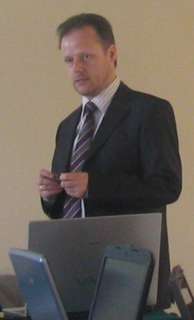Using multiple TMs in Trados Thread poster: Boris Tsikel (X)
|
|---|
Boris Tsikel (X) 
Canada
Local time: 19:30
English to French
Hello everybody,
Is it possible to use multiple memories, as in SDLX, when translating in Trados?
Thanks!
Boris
| | | |
| No, only 1 reference memory | Mar 12, 2009 |
Hi Boris,
no, there isn't any similar option. All you can do is select a reference memory (and only one).
Giuliana
| | | |
Jerzy Czopik 
Germany
Local time: 01:30
Member (2003)
Polish to German
+ ...
| Not directly, at least in current version | Mar 12, 2009 |
You only can use another TM for search purposes (read-only status) via the Concordance function. Opening of more than one TM in the Workbench is NOT possible.
However, the next generation to come, called SDL Studio, will offer this feature (is it really a feature?).
Best
Jerzy
| | | |
| A few possibilities | Mar 12, 2009 |
Hi Boris! Long time no see!
You have a few possibilities. Your ultimate choice will depend mostly on what use you wish to make of the memories.
1. You can load a memory in Workbench and a second (reference) memory that will only display results in the concordance window (you can copy and paste from there, but you can't insert the target segment directly).
2. You can merge several memories. Thi... See more Hi Boris! Long time no see!
You have a few possibilities. Your ultimate choice will depend mostly on what use you wish to make of the memories.
1. You can load a memory in Workbench and a second (reference) memory that will only display results in the concordance window (you can copy and paste from there, but you can't insert the target segment directly).
2. You can merge several memories. This is pretty simple: you open one memory, then you import a second memory into the first one, and so forth and so on. This way, you can combine an unlimited number of memories into one big memory, which many of us affectionately call 'big momma TM'.
3. You can load all of your different memories and bilingual (segmented) files in an ApSic XBench project. As you translate using Trados, you can look up whatever you want to in XBench - the number of files you can load into an XBench project is unlimited. I strongly recommend you install it and try it out. It is relatively easy to use and is a gem of a freeware for translators who use CAT tools. The simple, basic interface hides endless possibilities.
You can download XBench here: http://www.apsic.com/en/products_xbench.html
.
[Edited at 2009-03-12 19:32 GMT] ▲ Collapse
| | |
|
|
|
Boris Tsikel (X) 
Canada
Local time: 19:30
English to French
TOPIC STARTER | Thank you very much to all of you! | Mar 12, 2009 |
Viktoria, the tool seems to be great, indeed. Thank you a lot! But is it possible to do "fuzzy match" searches in it, too (to get a result even if words entered in serch field are not successive in the source texte)?
| | | |
| But of course! | Mar 12, 2009 |
To me, that's one of XBench's main advantages: you can search for a mere word stem, and as long as it is in one of the segments, it will show up. Moreover, XBench has a Power Search function - you can enter a few words and search for segments that contain those words, even if the words are not next to each other and not in the same order. Just enter a search string and hit Ctrl + P. You can also use boolean search (for example, you want segments that contain the word "Anthem" but that do not con... See more To me, that's one of XBench's main advantages: you can search for a mere word stem, and as long as it is in one of the segments, it will show up. Moreover, XBench has a Power Search function - you can enter a few words and search for segments that contain those words, even if the words are not next to each other and not in the same order. Just enter a search string and hit Ctrl + P. You can also use boolean search (for example, you want segments that contain the word "Anthem" but that do not contain "National").
Searching in XBench is much better than searching in Trados' concordance window.
Edited to add the following:
If you have a little bit of time, read the manual and get acquainted with the quality assurance features - unlike anything I've seen before! Very handy, because it often picks up things you wouldn't have picked up through normal reviewing.
You can also do searches both in source and target segments. You can even do a search using both at once. For example, you mistranslated a term a few times, and you only want to find the segments where you mistranslated the term and you don't want the segments where you translated it correctly. So, you would enter the source term in the source field, and then you would enter the wrong target term in the target field - or you can enter the source term, then enter the correct target term between quotation marks preceded by a minus symbol, and use power search.
One thing you will always need to remember is that, if you create a project with exported files (which are not updated as you translate), you will need to periodically export them again (overwrite the original exported file) and click on the reload button in the XBench interface. For files that are updated directly as you translate, you will still need to hit the reload button once in a while. If you don't do this, then changes will not be reflected in the search results and in the QA module.
When you want to edit a segment you just found in XBench directly within the actual bilingual document, you can select the segment in XBench and hit Alt + Ctrl + Enter - this opens the actual bilingual document you are working on (in Word for Word documents and in TagEditor for TTX files), the document is autmatically scrolled to the problem spot and the problem spot is highlighted. Just make sure the correct translation memory is open in Workbench when you do this. Also, I get a little bug when I do this: a Trados dialogue box is opened, asking me to pick a DTD definition file. If this happens, just click Cancel. This happens only the first time you try to edit a bilingual document directly. After that, it goes away. Also, when you use TagEditor and you open a file from within XBench, it may happen that the Open/Get button in TagEditor is greyed out. If this happens, locate the Connect to Workbench button on TagEditor's toolbar and click it. All buttons should then become available. Also, I get a little bug when I do this: a Trados dialogue box is opened, asking me to pick a DTD definition file. If this happens, just click Cancel. This happens only the first time you try to edit a bilingual document directly. After that, it goes away. Also, when you use TagEditor and you open a file from within XBench, it may happen that the Open/Get button in TagEditor is greyed out. If this happens, locate the Connect to Workbench button on TagEditor's toolbar and click it. All buttons should then become available.
[Edited at 2009-03-12 21:28 GMT] ▲ Collapse
| | | |
Boris Tsikel (X) 
Canada
Local time: 19:30
English to French
TOPIC STARTER | Thank you, Viktoria! | Mar 13, 2009 |
I’m really grateful you took time to provide all this valuable information!
| | | |
| Thank you Victoria! | Mar 14, 2009 |
I agree with Victoria and I second her that Xbench is a wonderful tool. I got to know it through one of Victoria's answers to a relevant forum thread I had begun some time ago and it has since been one of my best companions!
| | | |











